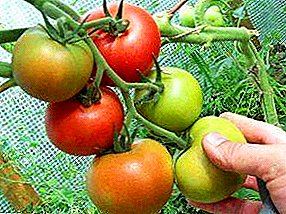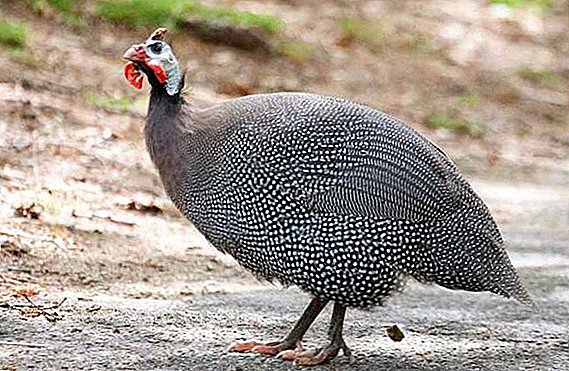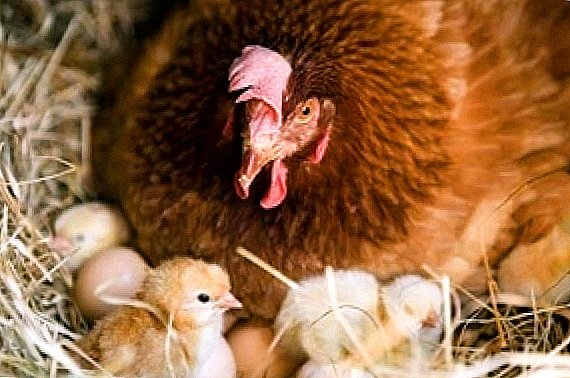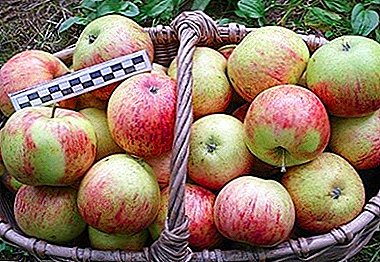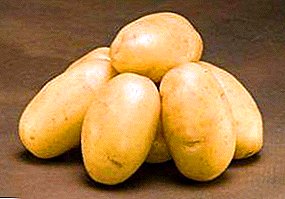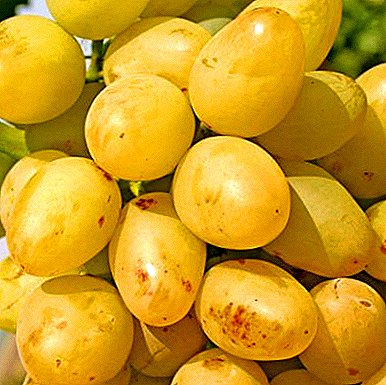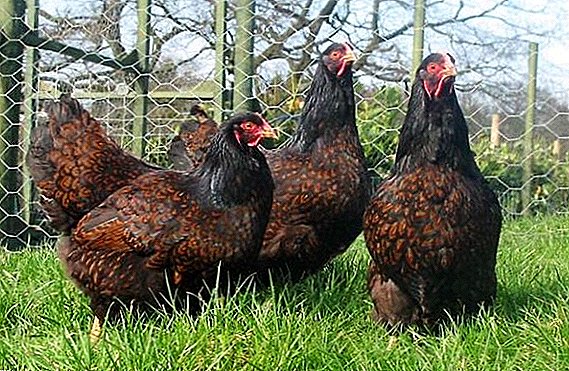 At the end of the 19th century, the demand for brown-shelled eggs increased, and buyers became more willing to buy them. Then the breeders began to cross different breeds to achieve chocolate-colored shells.
At the end of the 19th century, the demand for brown-shelled eggs increased, and buyers became more willing to buy them. Then the breeders began to cross different breeds to achieve chocolate-colored shells.
Birds, which managed to bring, called barnevelder, they gradually became widespread.
History reference
In a small town called Barneveld in 1850, farmer Van Esveld attempted to breed a new breed by crossing domestic birds with Kohinquin breed chickens, which were carried by eggs with a brown shell. Breeding work continued, rhode island, carad langshans, yellow orpingtones, pomfles, and Indian fighting pheasant-brown coloring were added to the ancestors of the breed. The result was the appearance of hens of beef breed, which showed good results of egg production and at the same time were carried by eggs with brown shells, although it was not possible to achieve a dark color.  At first, they did not want to recognize the breed, since it was difficult to isolate classification criteria, but after continuing the work on crossing and setting standards in 1923 (according to another version - in 1910), the breed was recognized.
At first, they did not want to recognize the breed, since it was difficult to isolate classification criteria, but after continuing the work on crossing and setting standards in 1923 (according to another version - in 1910), the breed was recognized.
Birds of this breed became very popular, they were gladly bred in their households, and soon they were taken to Germany and England.  After a few decades, the continuation of the improvement of breed standards and the fascination for raising chickens as decorative birds led to the appearance of a dwarf species of breed.
After a few decades, the continuation of the improvement of breed standards and the fascination for raising chickens as decorative birds led to the appearance of a dwarf species of breed.
It is interesting to get acquainted with the breeds and crosses of chickens: velzumer, maran, amroks, Hungarian giant, brown hawk, redbro, master gray, hubbard, highsex.
Description and Features
The breed Barnevelder differs in appearance, color, character, good egg production and incubation instinct.
Exterior
According to breed standards rooster:
- the constitution is strong, the forms are rounded, the landing is low, the length is 1/3 more depth;
- neck well feathered, not long, but not short;
- rib cage low planted, massive, with a characteristic bend;
- the back is not long, it is distributed in breadth, it is raised in the tail part;
- the wings are pressed against the body;
- the tail is tall, well-feathered, not very long;
- the stomach is low, large, is distributed in breadth;
- head is wide, not too high, no plumage on the face;
- the crest is small, with light plumage, covered with a thin skin, it can have 4-6 sharp tips;
- little beard round;
- earlobes are not very large, elongated, thin, red;
- beak dark yellow, massive, but short;
- eyes are bright orange with a red tint;
- hips large, well-defined, developed;
- the paws are not too long, the bone is thin, painted yellow;
- weight ranges from 3 to 3.5 kg.
 Have Chicken Breed standards include the following breed characteristics:
Have Chicken Breed standards include the following breed characteristics:
- the body is massive, the landing is low, the chest is wide, the abdomen is soft;
- the back is not very long, the rise in the tail section is characteristic;
- the tail is massive at the body, tapers and opens upwards;
- feet yellow with a gray tinge;
- weight ranges from 2.5 to 2.75 kg.
The weight of a dwarf variety is no more than 1.5 kg, more often 1 kg.  Birds should not have:
Birds should not have:
- narrow, too high or too low body;
- narrow back;
- sharp break of the back line;
- narrow pointed chest;
- narrow abdomen;
- narrow or chopped off tail;
- feathered paws;
- enamelled earlobes.
Did you know? Chickens well remember the faces of people, they will recognize the owner from a 10-meter distance.
Color
Barnevelder chickens can be colored like this:
- colored;
- in white or black color.
Colored colors include dark brown, red, white, lavender gray, black with double edging in black or white.  Red brown It has a double dark edging on the feathers. Birds have black spots on their necks, and their tails are black with overflows of blue-green hue. On the wings, the plumage is dark-brown on the outside, black on the inside with a brownish tint. This type of color is characterized by the brown color of one shade, the black plumage should not be too much.
Red brown It has a double dark edging on the feathers. Birds have black spots on their necks, and their tails are black with overflows of blue-green hue. On the wings, the plumage is dark-brown on the outside, black on the inside with a brownish tint. This type of color is characterized by the brown color of one shade, the black plumage should not be too much.  Birds saturated of red color on feathers have double black edging.
Birds saturated of red color on feathers have double black edging.
Black color hen is characterized by white double edging, it is white with black edging.
Lavender gray edging on brown feathers - This is a mutation recognized in the Netherlands. In the US, only chickens of red-brown color with dark edging are recognized. In Great Britain, unlike other countries, birds of red color with white double edging, white tail and belly are recognized. In most countries, the color of the cuckoo type is not recognized - a light brown neck, a darker body feathering color, a white edging, a white base of feathers.  The double edging is characterized by the presence of two edges - in the outer outline and another in the middle. Birds have black or chestnut feathers on the neck and back, on the edges are greenish or black edging, the middle is chestnut. Double edging is also on the chest, thighs, abdomen.
The double edging is characterized by the presence of two edges - in the outer outline and another in the middle. Birds have black or chestnut feathers on the neck and back, on the edges are greenish or black edging, the middle is chestnut. Double edging is also on the chest, thighs, abdomen.
Chicken breeds of brekel silver, Chinese silk, bielefelder, Pavlovskaya, dominants have an interesting appearance.
The color should not be dull black, light brown, the rooster should not have white plumage on the inside of the wings and on the tail.
Black color characterized by a greenish-blue tint, few brown shades.  White color includes shades from cream to light silver shade, without yellow tone.
White color includes shades from cream to light silver shade, without yellow tone.
In the Netherlands, only dwarf barnewelders can have a silvery shade.
The color of the chickens is light brown, dark brown, black, yellow with a brown back. 
Character
Barnevelders are not pugnacious, peace-loving, get along well with other breeds of chickens, as well as with domestic birds and animals, they are not afraid of people, do not rush at them.
Did you know? In order to carry the eggs, the hens do not need a rooster, but chickens will not hatch from such eggs.
Annual egg production
Barnewelders are very productive: starting to be born at 7 months of age, they annually demolish about 180 eggs weighing at least 60-70 g each. In winter, these birds continue to be carried. Their eggs are in a brown shell. Dwarf breed rushes eggs weighing about 40 g.
During the molt period, which lasts about 2 months in the fall, chickens do not rush. Birds egg production deteriorates after reaching 3-4 years of age.
Find out what to do if chickens do not carry well, carry small eggs, peck eggs, and also what raw eggs are good for.
Hatching instinct
The nestling instinct in chickens is well developed, they care not only about their offspring, but they can also hatch eggs of other breeds. On average, about 95% of eggs survive, and chickens hatch from them. 
Conditions of detention
To provide good conditions for chickens in Barnevelder is to build a chicken coop correctly and equip a yard for walking.
Coop Requirements
This breed of chickens should move a lot, so it's best not to keep them in cages. If you do not give the barnevelders the opportunity to walk a lot, they will begin to have joint diseases on their paws.
The coop should be spacious enough to 1 square. m had no more than 5 chickens, and better - 3. Well, if it is covered from the north by another building, then it will not be blown by cold winds - drafts have a bad effect on the health of birds. However, small air vents with grilles should be foreseen, the air in the room should not stagnate.
Ventilation allows you to control the temperature and humidity in the chicken coop. This contributes to the normal development of the bird and helps to increase the economic efficiency of its breeding process.
In addition, birds need good illuminated, there should be windows in the hen house. In order for them to carry eggs, it should be light at least 17 hours a day, so additional lighting is necessary by artificial means, especially in winter.  An important condition for the content is the absence of high humidity and floods, so it is better to make the foundation under the chicken coop columnar. Then torrential rains or melting snow will not flood it, it will always be dry there.
An important condition for the content is the absence of high humidity and floods, so it is better to make the foundation under the chicken coop columnar. Then torrential rains or melting snow will not flood it, it will always be dry there.
Floors they will hold heat well if they are covered with clay, and in the process of keeping sand, sawdust or shavings. To keep the hen house clean, the mound should be periodically changed, so its consumption will be about 15 kg per year per bird.
We advise you to read about the choice and purchase of a chicken coop, independent production and improvement of the chicken coop.
Walls in the chicken coop, you can build from wood, brick or cinder block, the first option is good because it does not require additional insulation and heating in winter. In order to provide good conditions for Barnevelder, the temperature in the room should be between +18 and +25 ° C.
In the wall, an opening is provided for the entrance and placed at a distance of 20 cm from the foundation, covering it, constructing a small passage in the form of a corridor, and hanging the door.
At 1 m from the floor with rods equip roosts, the distance between which should be about 30 cm, and their diameter - 5 cm. 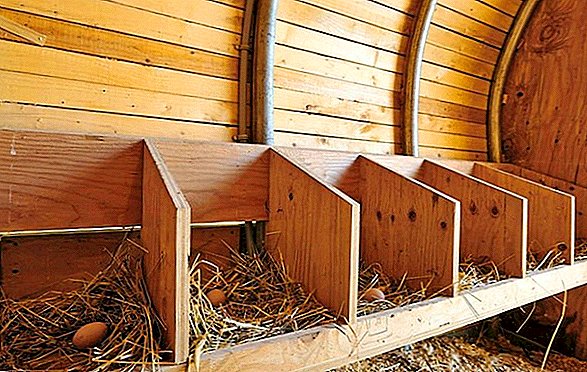 In a dark place, nests are set up with the help of straw, fluff, sawdust, seeds from the husk, so that the chickens are carried.
In a dark place, nests are set up with the help of straw, fluff, sawdust, seeds from the husk, so that the chickens are carried.
To protect against fleas, chickens take dry baths of sand mixed with ashes. This mixture is poured into boxes of about 0.5 square meters. m
A prerequisite is the presence of feeders and drinkers, which must be equipped so that the birds can not scatter food from there and crawl into the middle. Separately set the feeder for chalk or seashells.
Get acquainted with the breeds of hens of egg, meat, meat-egg, decorative direction.
Courtyard for walking
Near the chicken coop, it is necessary to provide for a walking area of 2 times the size of the chicken coop, which is enclosed with a fence not less than 2 m high, otherwise the birds may cross it. The territory should be away from the garden, otherwise the chickens will dig it and destroy the crop.
It should also be provided with a canopy to provide the barnewelders with the opportunity to hide from the scorching sun in the summer. 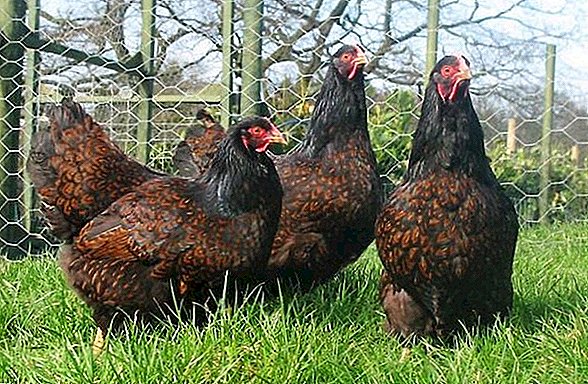
How to endure cold
Cold birds tolerate well. In the absence of severe frosts, the bird can be walked in winter. Make sure that the temperature in the chicken coop does not fall below +5 ° C.
Learn more about the maintenance of chickens in the winter season: how to build a chicken coop for the winter and make room heating.
What to feed adult chickens
Barnewelders are unpretentious in food. Although in Europe they are fed with mixed feed, in our conditions they willingly eat grain, boiled eggs, cottage cheese, and corn flour.
Important! In the composition of the feed about 60% should be grain - barley, millet, wheat, corn, sorghum, oats, rye, buckwheat.
Feed them twice a day:
- in the morning - about 8 o'clock;
- in the evening - about 17 hours.
The total amount of food per day is 75-150 g. After 0.5 hours after feeding, the remnants of food are removed so that the birds do not swim with fat.
If calcium is not given to the birds, the quality of the eggs may suffer. Therefore, they are fed with chalk, pounded with shells, crushed shells, and slaked with lime.  Food should provide the protein intake in the body of chickens, for this they are given nettle, clover, tops, alfalfa, yeast, flour, beans. Yeast is given in diluted 15 g per day. To do this, 30 g of yeast is dissolved in 3 liters of warm water and infused for 8 hours.
Food should provide the protein intake in the body of chickens, for this they are given nettle, clover, tops, alfalfa, yeast, flour, beans. Yeast is given in diluted 15 g per day. To do this, 30 g of yeast is dissolved in 3 liters of warm water and infused for 8 hours.
Fat is a necessary component, they come with cottage cheese, bone meal or fish meal (the latter in small quantities, so as not to spoil the taste of eggs).
To have a lot of eggs from chickens, it is not enough to choose a breed with high egg production for breeding. It is important to properly organize their diet, providing all the necessary substances and vitamins.
The intake of carbohydrates in the body will provide food from grains, potatoes, beets, zucchini and other vegetables. If the grain is first germinated, it will have more vitamins E and B.
Chickens should always have access to clean and fresh. water. They also need gravel, which can be scattered in the place of walking.
Breeding chicks
Breeding barnevelders is easy, it is enough to provide good care for the young.
Hatching eggs
To breed this breed, you can use the incubator, putting there the eggs bought or laid by their own chickens. You can also lay eggs under the hen hen or buy hatched chickens.
Important! Of the total, about 94% of Barnevelder breed chickens survive.
Care for the young
After hatching, chickens need constant round-the-clock illumination and an ambient temperature of + 35 ° C. After 2 days, the need for constant illumination disappears, and after 7 days you can begin to gradually reduce the air temperature. To increase chickens disease resistance, they should be vaccinated.
Chicken Diet
Immediately after hatching, chickens are fed every two hours; after 7-10 days, 5 meals will be sufficient. Begin to feed the chicks boiled egg, which is rolled in semolina, so as not to stick to the fluff. From the next day, you can begin to add cottage cheese, millet, vegetables, nettles, after 5 days they introduce gravel, sand, and mineral additives. It is possible to give the compound feed intended for chickens. Grain in its entirety begins to be given one month after its birth.  Chickens need access to clean water, milk should be discarded due to possible complications of digestion.
Chickens need access to clean water, milk should be discarded due to possible complications of digestion.
Herd replacement
Chickens retain the ability to lay eggs for more than 10 years, but after 3-4 years the number of eggs laid is reduced, and their size decreases. In addition, chicken meat becomes more rigid and less tasty. Therefore, periodically carry out the replacement of the herd for young.
Advantages and disadvantages
The advantages of the breed include:
- peaceful nature;
- unpretentiousness;
- good egg production;
- large eggs;
- pleasant taste of meat;
- beautiful appearance and color of eggshell;
- meat-egg breed;
- propensity to incubate offspring;
- high survival of offspring;
- disease resistance;
- relative cold resistance;
- opportunity to participate in exhibitions.
However, breeding breed has its disadvantages:
- tendency to diseases of the joints;
- the need to provide a spacious chicken coop and free fenced territory for walking;
- high cost.
Video: barnevelder chickens silver
Thus, the barnevelder is very beautiful chickens that will delight you not only with an attractive appearance, but also with tasty meat, an abundance of eggs with a brown shell. You do not have to sweat too much, creating the conditions for their maintenance, but proper care is necessary, especially with regard to the spacious territory and premises. But you have to take into account that for the opportunity to have such birds you need to fork out a little.




